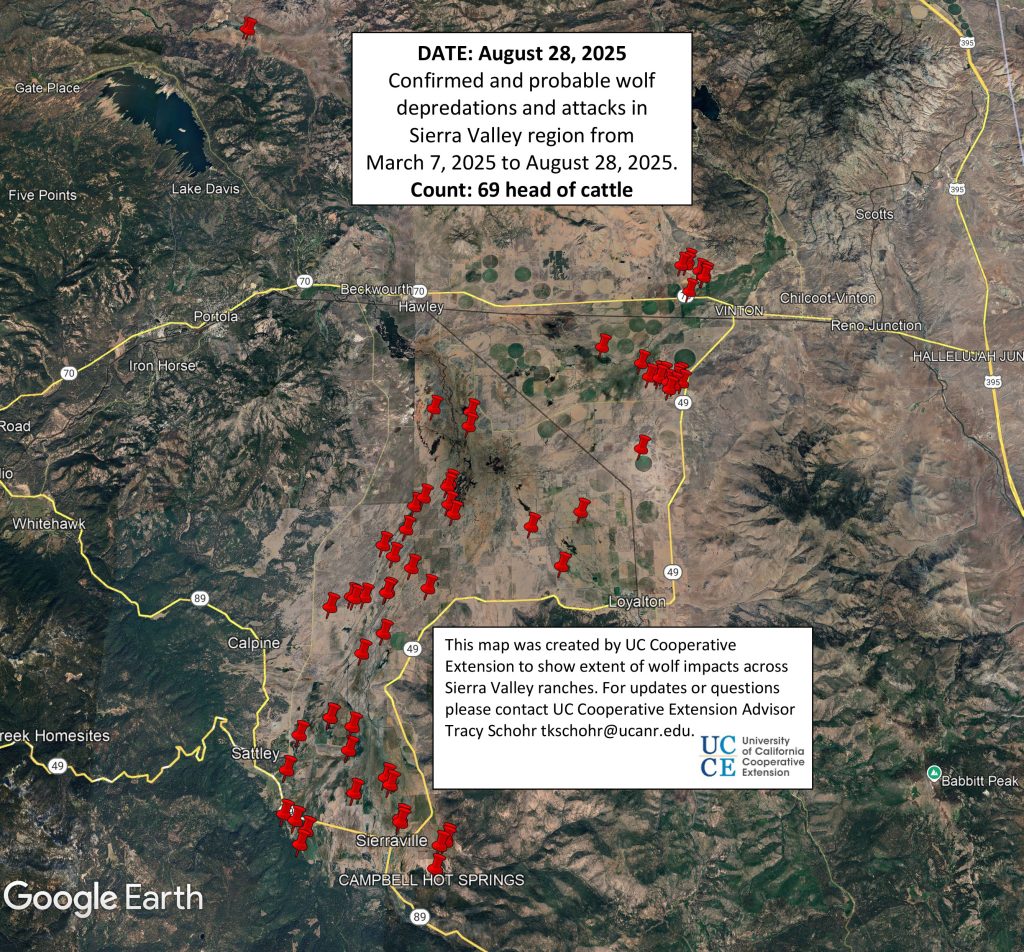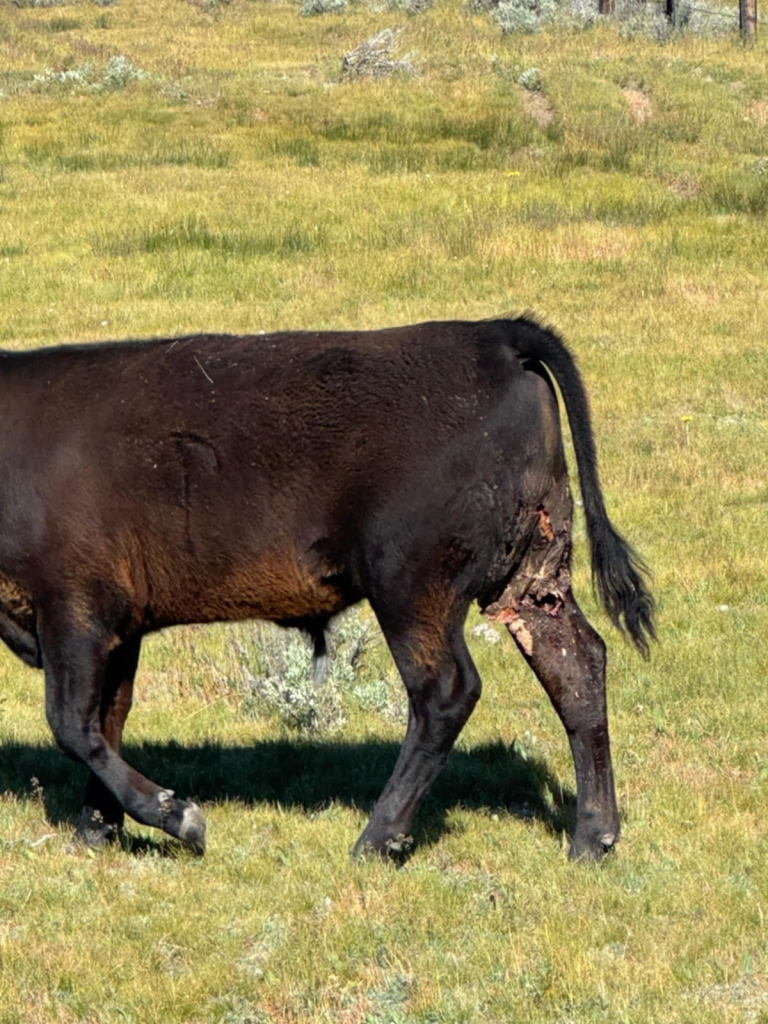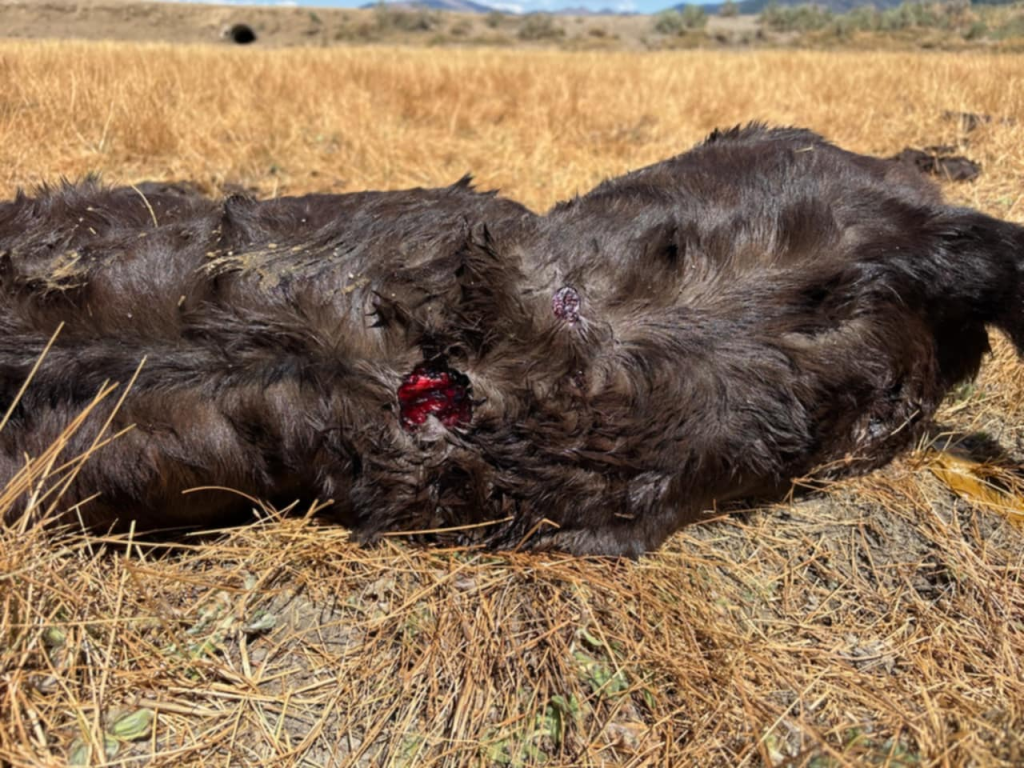Wolves have killed at least 37 head of cattle on Paul Roen’s California ranch this year.
Roen, a Sierra County Supervisor (akin to a County Commissioner) and ranch manager said “It has been an absolute massacre” and his county sheriff Mike Fisher agrees, saying, in a Fox 40 television news story that the loss in Sierra Valley is “unprecedented.”
“There is nowhere else in the nation that has seen the amount of depredation in such a short amount of time,” said Fisher.
Wolves are on the federal and California Endangered Species Lists and are thus protected from being killed, even if they kill livestock.
As of Sept. 5, 2025, federal agents confirmed that wolves had killed 73 head of cattle in the Sierra Valley, located in northeastern California. In reality, wolves have probably killed and eaten at least another 10-15 head of livestock, but evidence protocols need to change in order for those to be on the official count, said Roen.
Some ranchers met Sept. 4 with U.S. Fish and Wildlife Service regional director Paul Souza to once again request removal of the wolves. They also explained that the protocol for proving a wolf kill needs to be adjusted. “According to protocol, we have to have evidence of hemorrhaging or bite marks. There have been several that have been killed, but there is nothing left of the carcass,” said Roen. “You walk around and there is literally nothing left but maybe pieces of bone. It’s disgusting,” he said.
The state does compensate ranchers for proven wolf kills. Kirk Wilbur, the California Cattlemen’s Association Vice President of Government Affairs points out that wolves – and the destruction they leave behind – put a mental strain on ranchers that has no price tag.
“Ranchers aren’t out here raising livestock to be maimed in the night and euthanized in the morning. They aren’t raising livestock to be killed. They are raising livestock to provide food for Californians, for the world, and to do that in a humane manner, even at the point of slaughter. Getting a check from the state isn’t what they want – there is a lot more of a mental and emotional toll that comes along with the loss of livestock in a traumatic way, that those outside of the livestock industry don’t understand,” he said.
Wilbur also points out that the compensation program is only as good as the funding provided by the legislature each year, which could dry up at any point, but thus far has been sufficient ($600,000 last year and $2 million this year).
The California Department of Fish and Wildlife told TSLN that the state’s efforts to deal with wolves are focused “exclusively on non-lethal deterrence methods” through its specialized “strike team” that attempts to haze wolves away from livestock.
“It is unlawful for any individual to harass or kill wolves. Livestock producers, however, may take lawful actions to protect their animals from other predators,” said the agency.
If a rancher were to kill a wolf, the CDFW would refer the individual for prosecution.
TSLN called Roen twice for phone interviews, and both times, he was busy investigating wolf depredations.
“I got in at three this morning and left at six to go to another kill,” he said in the first conversation.
Roen said wolves killed 16 head of cattle in Clover Valley last fall. He believes those wolves followed a herd of cattle that summers in Clover Valley and winters in Sierra Valley.
“We know how they got here. They followed the cows. We watched them come down behind the cows last November,” said Roen.
“It’s unbelievable what’s happened here in the last six months,” said Roen. A pair of adults with six pups lives in a den about a mile from his home.
Roen said the California Department of Fish and Wildlife recently began putting out food for the wolves at the den site in an effort to minimize livestock kills, but Roen doesn’t believe it has been effective. The one difference he has seen is more carcasses not being eaten. “The adults are killing and eating the insides of the animals,” he said.
Ranchers have found several injured animals that had to be euthanized, and the wolves are capable of killing all sizes of cattle. “Whatever they run into, they kill or maim it. We’ve had to put down several yearlings throughout the valley. They eat them alive. They start to eat them and then run off and you’ll find them alive. It’s absolutely disgusting. I don’t know how anyone can say this should be tolerated,” he said.
“Last Sunday morning, I saw collared wolves leaving a kill, transporting a kill, trot by cows and calves. Then two wolves grabbed a cow and a third wolf took the calf. We are not going to co-habitate with these animals. They have to be removed,” he said.
In some cases, Roen has found evidence of kills where there is “nothing left but a piece of bone and a blood spot.”
There was one wolf kill discovered in Sierra Valley around the middle of March. The next was April 6, and it just went on from there, he said.
The Roens brought their cows to the valley in May and immediately suffered losses. “We lost three cows, nine yearlings,” he said.
Early fall calving started on his ranch in July, which then brought on two to three kills per night, he said.
A deer was killed in a subdivision and an elk killed on the front porch of a home. The county declared a state of emergency due to concern for public safety, which helps bring more urban attention to the issue and gives the county a pathway for working together with other counties facing the same battle.
Roen said he is working with the regional director of the U.S. Fish and Wlidlife Service in an effort to get a federal order allowing the offending wolves to be removed.
With the help of a USFWS drone team, the ranchers realized that the wolves’ collars were not functioning during nighttime hours, so attempting to haze them away from cattle at night had been futile.
In the mornings, the data on the wolves’ locations downloads, and Roen said he can usually head out to investigate “clusters” of “pings” from the collars. He often finds a dead calf at such locations.
The California Cattlemen’s Association supports delisting of the gray wolf on the state and federal level.
Wilbur said the state has said it will not consider delisting unless it can maintain eight breeding pairs for two successive years. Their definition of a “breeding pair” is a male and female who have at least two pups that survive through December 31 of a given year. He said as of the end of last year, there were five known breeding pairs and he expects the state to meet the threshold of eight very soon.
At that time, the CCA plans to petition for state delisting, but realizes the state may resist.
Wilbur points out that both the Obama and Trump administrations have been supportive of delisting the gray wolf, and he believes now is the time. “Wolves have re-populated and revived. And we are seeing a steep curve of re-population in California. The science-backed concept of delisting is bi-partisan. I don’t think it should be controversial,” he said.
 The “pins” on this image show confirmed wolf kills in 2025 in the Sierra Valley of California. Paul Roen says there are likely another 10-15 kills that couldn’t be confirmed because they carcasses were eaten when discovered. UC Extension | Courtesy image8.28.2025-Depredation-Map-to-Printer77-1
The “pins” on this image show confirmed wolf kills in 2025 in the Sierra Valley of California. Paul Roen says there are likely another 10-15 kills that couldn’t be confirmed because they carcasses were eaten when discovered. UC Extension | Courtesy image8.28.2025-Depredation-Map-to-Printer77-1
 In addition to livestock being killed, some are injured to the point that they need to be euthanized. Paul Roen | Courtesy imagesimage-20
In addition to livestock being killed, some are injured to the point that they need to be euthanized. Paul Roen | Courtesy imagesimage-20
 Wolves are big enough that killing a cow seems to be no problem. image-19
Wolves are big enough that killing a cow seems to be no problem. image-19
 image-18
image-18
 image-17
image-17
 image-16
image-16